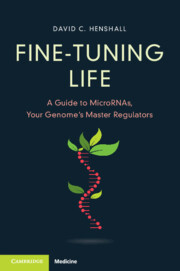Book contents
- Fine-Tuning Life
- Reviews
- Fine-Tuning Life
- Copyright page
- Dedication
- Contents
- Figures
- Ode to the MicroRNA
- Acknowledgements
- Common Terms and Definitions
- Introduction
- Chapter 1 Discovered!
- Chapter 2 MicroRNAs Emerge as Master Controllers
- Chapter 3 Epic Journey
- Chapter 4 Opening Act
- Chapter 5 MicroRNAs Shape the Machinery of Our Minds
- Chapter 6 Centre of the Electrical Storm
- Chapter 7 MicroRNAs Become Medicines
- Chapter 8 Circulating MicroRNAs Provide a Diagnosis
- Chapter 9 Finale and Encore for MicroRNAs
- References
- Index
Chapter 8 - Circulating MicroRNAs Provide a Diagnosis
Published online by Cambridge University Press: 14 June 2024
- Fine-Tuning Life
- Reviews
- Fine-Tuning Life
- Copyright page
- Dedication
- Contents
- Figures
- Ode to the MicroRNA
- Acknowledgements
- Common Terms and Definitions
- Introduction
- Chapter 1 Discovered!
- Chapter 2 MicroRNAs Emerge as Master Controllers
- Chapter 3 Epic Journey
- Chapter 4 Opening Act
- Chapter 5 MicroRNAs Shape the Machinery of Our Minds
- Chapter 6 Centre of the Electrical Storm
- Chapter 7 MicroRNAs Become Medicines
- Chapter 8 Circulating MicroRNAs Provide a Diagnosis
- Chapter 9 Finale and Encore for MicroRNAs
- References
- Index
Summary
Shortly after microRNAs were discovered in humans they were found to be present in blood samples. This led to another branch of microRNA research with the potential to transform medicine, answering the question healthcare professionals ask every day. What’s wrong with my patient? This chapter introduces circulating microRNAs as biomarkers and their emergence as potential diagnostic tools. Core arguments in their favour as indicators of health and disease include tissue specificity, their known locations in the body enabling doctors to zero in on where a problem lies. It looks at what shelters microRNAs as they circulate in the bloodstream and the disruptive thinking that has interpreted such findings as evidence that extracellular microRNAs are conveyors of information between distant tissues in the body. It moves to efforts to probe ever-smaller volumes of biofluids to find the least-invasive source of microRNA biomarkers and the diseases for which microRNA-based diagnostic tests already exist or may emerge in the future. Finally, it looks at developments in RNA detection technology that might allow point-of-care testing and perhaps microRNA-based health monitoring at home.
Keywords
- Type
- Chapter
- Information
- Fine-Tuning LifeA Guide to MicroRNAs, Your Genome's Master Regulators, pp. 211 - 231Publisher: Cambridge University PressPrint publication year: 2024

